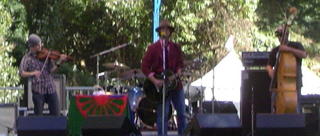HSB Day 2, plus, I Am Cuba
 Unlike his boss John Prine, Todd Snider is best as a comedian, and that goes double in a setting like this. His stage schtick is impeccable (like the one about the grandpa who died "peacefully in his sleep, unlike the other occupants of the car") and his back catalogue has plenty of LOL moments, like his statistics song. His latest album, East Nashville Skyline, tops these easily, for example with "The Ballad of the Kingmen", which starts out telling the story of the "Louie Louie" band, but by the end has meandered into quoting "Let's Get It On"; and "Conservative Christian Right Wing Republican Straight White American Males", c.f. "tree-hugging, peace-loving, pot-smoking, porn-watching lazy ass hippies like me". That last one got the bastard an unprecedented encore. Good show.
Unlike his boss John Prine, Todd Snider is best as a comedian, and that goes double in a setting like this. His stage schtick is impeccable (like the one about the grandpa who died "peacefully in his sleep, unlike the other occupants of the car") and his back catalogue has plenty of LOL moments, like his statistics song. His latest album, East Nashville Skyline, tops these easily, for example with "The Ballad of the Kingmen", which starts out telling the story of the "Louie Louie" band, but by the end has meandered into quoting "Let's Get It On"; and "Conservative Christian Right Wing Republican Straight White American Males", c.f. "tree-hugging, peace-loving, pot-smoking, porn-watching lazy ass hippies like me". That last one got the bastard an unprecedented encore. Good show.[[Aside: There are surprisingly few CCRWRSWAMs; the thing about the Republicans is that currently you only have to be either/or to with them: either conservative Christian or economically right wing, whereas to be with the Democrats you have to be socially liberal/noncommittal AND economically centrist/left. Thus last year Kerry won the centre and still lost the election. The consolation for some Democrats is that the "either/or" strategy leaves you with an unstable coalition. Others of us wonder aloud how America ended up with only two parties, and shitty ones at that.]]
 The rest of the day: Hazel Dickens, arguably bluegrass's greatest songwriter, was not in good voice. Kevin Welch, Kieran Kane and Fats Kaplin were agreeable. Guy Clark was fine, if you don't mind that he's even more low-key now than he was in '75. The Songwriters' Circle was a bit of a letdown, with Joe Ely, Steve Earle, Dave Alvin, Guy Clark (obscured) and Verlon Thompson (not pictured) playing three songs each and not interacting with each other. Rosanne Cash is a better singer than her late mother and a worse one than her great father. Her rocky new stuff was interesting, but I ran off early to get to the Balboa and see...
The rest of the day: Hazel Dickens, arguably bluegrass's greatest songwriter, was not in good voice. Kevin Welch, Kieran Kane and Fats Kaplin were agreeable. Guy Clark was fine, if you don't mind that he's even more low-key now than he was in '75. The Songwriters' Circle was a bit of a letdown, with Joe Ely, Steve Earle, Dave Alvin, Guy Clark (obscured) and Verlon Thompson (not pictured) playing three songs each and not interacting with each other. Rosanne Cash is a better singer than her late mother and a worse one than her great father. Her rocky new stuff was interesting, but I ran off early to get to the Balboa and see...I Am Cuba (dir. Mikhail Kalatozov)
Holy crap. Early on there's one of the wildest takes you'll ever see, starting on top of a building, careening down and across the city and ending up underwater in a swimming pool. Cinematogapher Serguey Urusevsky has many tricks up his sleeve, but this is the sequence is the one that combines choreography in front of the camera (credit Armando Suez) and behind it, in a manner perhaps only matched by Sokurov's Russian Ark. The most distinctive feature of the rest of the film is its inclination to the oblique: few narratives have withheld the square-on view so determinedly. It makes you conscious of the existence of a world beyond the frame, which is a bad idea in a propaganda flick that's trying to sweep you along with: it reeks of artifice.
The story is what it is. The first of four sections shows a beautiful (of course) girl whoring herself out to Americans; not a bad allegory but a bad story. Then a tenant farmer has his land sold from under him. So we've seen how both urban and rural Cuban were being oppressed; the second half shows us what the do about it. A student takes part in a revolt against Batista's regime, becoming a leader. And a peasant refuses to harbour a revolutionary, but shockingly winds up joining the cause. These later sections, a little Commier than Gladiator, are more old-style agitprop in their heart-tugging and are thus much more effective.
It's impossible for me to think of Castro as a great leader just because he wasn't Stalin or Mao, and he looks pretty bad in most accounts of the Cuban Missile Crisis, but credit him for being the dictatorial Marxist leader who has most improved his people's lives relative to their neighbours (read about modern Haiti, and consider that there wasn't much economic difference between the two countries in the Fifties). I Am Cuba is weird because, oppression nothwithstanding, it paints at least some parts of pre-revolutionary Cuba as paradise. No wonder the Cubans and Russians hated it. As propaganda, it only works on aesthetes. And which dictator needs them?

0 Comments:
Post a Comment
<< Home